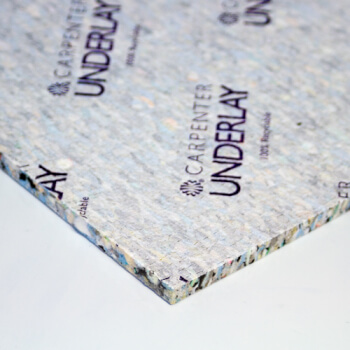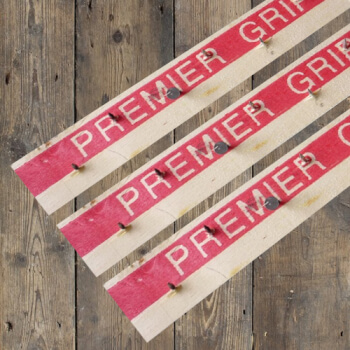Underlay and Soundproofing
By Jim (16/03/2018)
Hi everyone!
We have already written a blog on how to choose the right underlay, but this time we are going to focus in on one particular area - soundproofing.
Many people - especially those with big families or downstairs neighbours - are concerned with the amount of background noise in their home. In particular, echoey spaces can quickly becoming difficult - two or three people talking becomes very overwhelming!
Having the right flooring goes a long way to avoiding these issues - here is a brief overview of how soundproofing works, and what makes a good acoustic underlay...
Sound and Soundproofing
To understand how soundproofing works we first need to understand sound itself; sound is a form of energy, like light and heat. It is produced by vibrations - when something vibrates, it sends waves of pressure outward from the source.
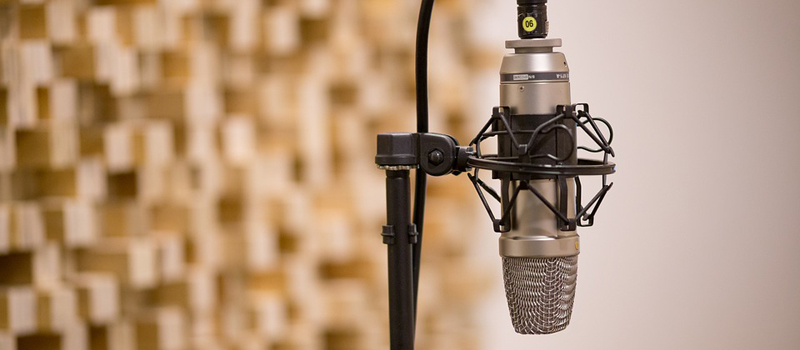
Recording Studio With Sound Proof Walls - Image Found On MaxPixel
These waves are transferred through the atoms in matter which can be solid, liquid or gas. A particular type of matter is known as a ‘medium’ - for example air, metal, water and rubber are all mediums through which sound can travel with various results. Unlike light, sound requires atoms to travel, which is why it can’t travel in a vacuum environment like space.
Inside the human ear are various organs - eardrums, the trio of bones known as the ‘ossicles’ and many small hairs - which allow us to perceive the waves as an audible signal. Non-hearing people may still be aware of the pressure wave, but as feeling rather than sound.
The fact that sound is transferred via atoms means that is actually travels more efficiently through liquids and solids than it does through air - so creaking floorboards and gurgling pipes can be audible all over the house when human voices are harder to detect. Also anyone who has been unfortunate enough to have a neighbour who puts their bass speakers up against a wall will know this first hand!
Sound waves can also be diffracted around corners and get through very small spaces, which makes effective soundproofing a challenge.
The Basics Of Soundproofing
There are three ways of soundproofing - first is noise reduction, which is essentially preventing sound from entering a space, the second is noise absorption. The third is a technique called ‘decoupling’, which involves creating a separate space within a space - this is primarily used for sound recording studios and scientific experiments so we won’t go into it here, instead focusing on reduction and absorption.
○ Noise Reduction
Reduction entails blocking any potential entrances for sound - vents, cracks, imperfect windows seals, loose-fitting doors, warped floorboards etc. A general rule of thumb is that anything that might let in a draft will let in sound (although that doesn’t mean that anything which stop heat escaping will also block out sound), so structural integrity is a number one concern.
Double and even triple glazing (relatively new here but a standard in Germany since the early 2000s and the founding of the PassiveHaus Institute) will certainly help to soundproof, as well as making things more comfortable in winter - still, there is a limit to what can be done with noise reduction on its own.
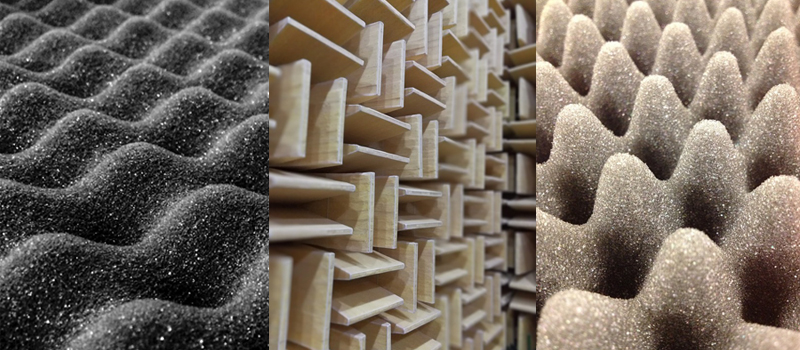
Various Soundproof Materials - Images Found On MaxPixel and Cutfoam
○ Noise Absorption
Noise absorption is the next step, and this is where underlay comes in - this means using materials that ‘soak up’ noise. In scientific terms they work by converting sound energy into heat.
Some are porous, with small chambers or ‘cells’ within the material - these includes things which are primarily used in professional sound environments, like acoustic foam and Mass Loaded Vinyl.
However, more commonplace materials like duvets, cushions, blackout curtains and - of course - underlay, work on a similar principle.
Measuring Noise Absorption
Sound is measured primarily in decibels (dB) which is a logarithmic scale, meaning every 10db represents x 10 increase in power. That means 50db is not 5 times louder than 10db - it’s actually 100 times louder! To put this in context, a car passing at 60 miles an hours in around 70dB, whereas someone whispering would be 20dB.

Cross Section of Polyurethane Underlay, Showing The Porous Structure - Image © Designer Carpet
Most materials will have a dB rating, which is generally a measurement of the total sound reduction achieved after the sound has passed through the soundproofing material.
There are other ways of measuring sound reduction such as the NRC or ‘Noise Reduction Coefficient’ which measures how well materials stop sound from reflecting - it is measured as the percentage (displayed as a decimal point) of sound which is absorbed.
For example, a material with an NRC of 0.5 would absorb 50% of the sound, and 50% would be reflected.
The Best Acoustic Underlay
Most underlay - and you can read about the different types here - is porous, like crumb rubber or polyurethane. Others, like felt, are composed of many layers sandwiched together- some, like foam rubber, combine both features. The overall sound absorption is based on a number of factors, not just the material type.
There are many different underlays which are billed as ‘acoustic underlay’, specifically designed for sound absorption. We have compiled a comparison chart of other popular underlays - including two of the products we sell, Carpenter Prostep 8mm and Ultimate Living 10mm - to give you an idea of the performance.
You can download a .PDF copy by clicking here.
NB: All details including prices are accurate as of the date of publication, if you notice any errors please do contact us and let us know.
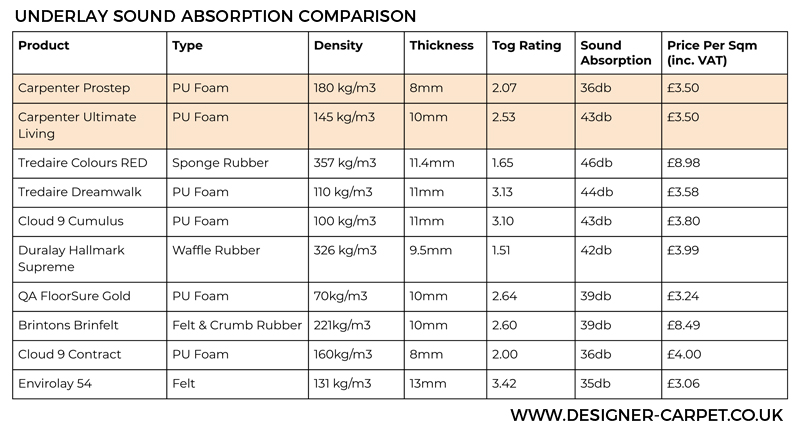
Underlay Comparison Chart - Image © Designer Carpet
As you can see, the thickness of the underlay doesn’t necessarily equate to the level of sound absorption - nor does the density.
There are many other choices of underlay of course - we think the products we supply give a good all-round balance of price, thickness and sound absorption.
These Carpenter underlays also have many other advantages - they are guaranteed for the whole lifetime of a carpet (usually ten years or more), made from recycled material (which is also re-recyclable when it is finished with - perhaps we should have given Carpenter a mention in the last blog?), flame retardant and consistently outperform traditional rubber underlays.
So, now you know a little more about soundproofing, and how underlay can help you get some peace and quiet! If you need any further information about our products or about underlay in general, please do get in touch with us via phone or e-mail.
Until next time!
Further Reading On Soundproofing...
Enter your required size for our most accurate pricing and availability.








